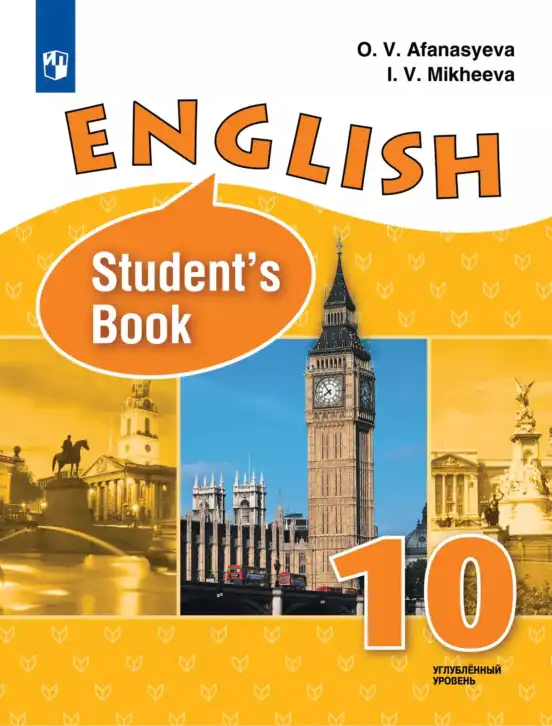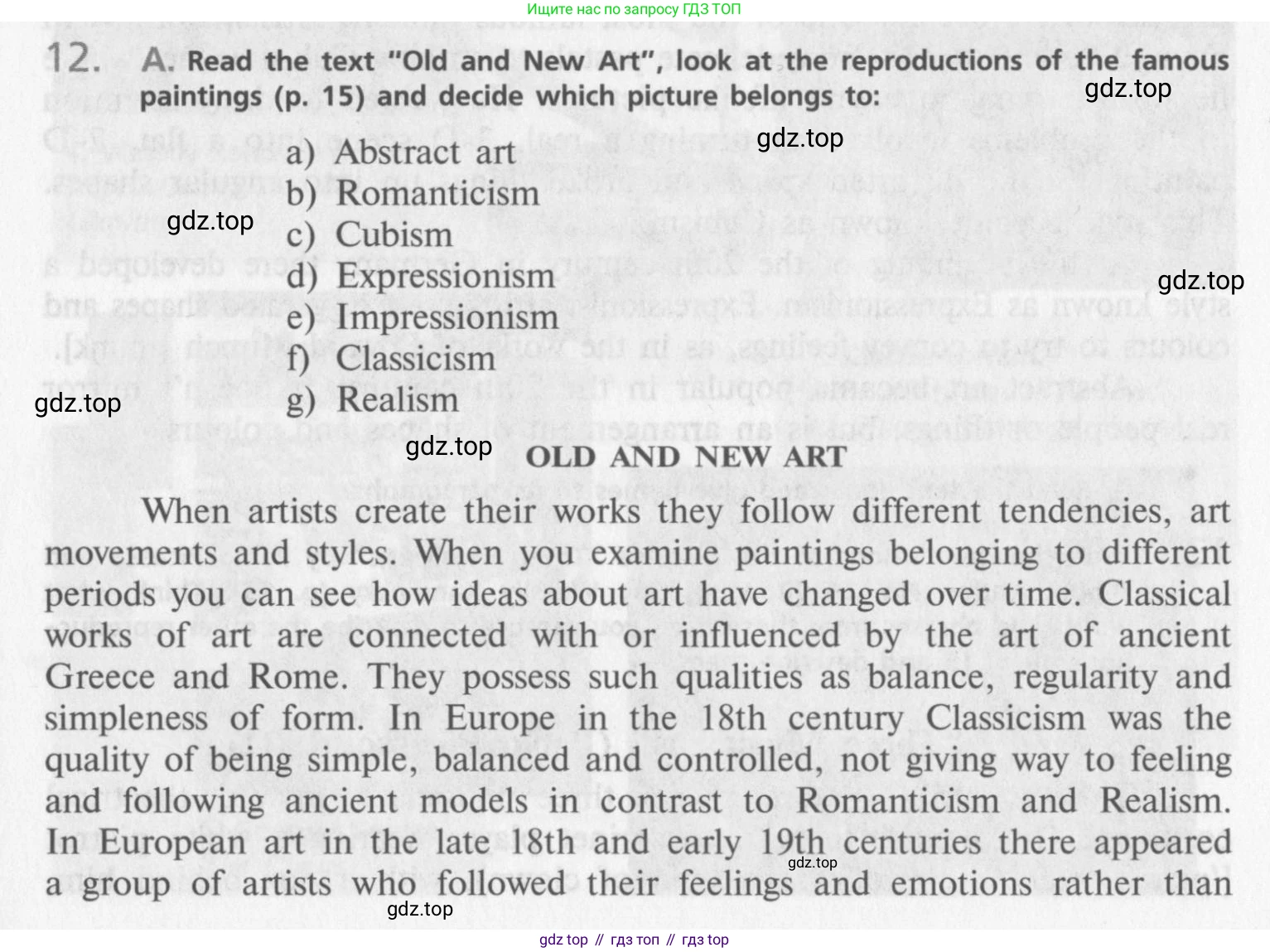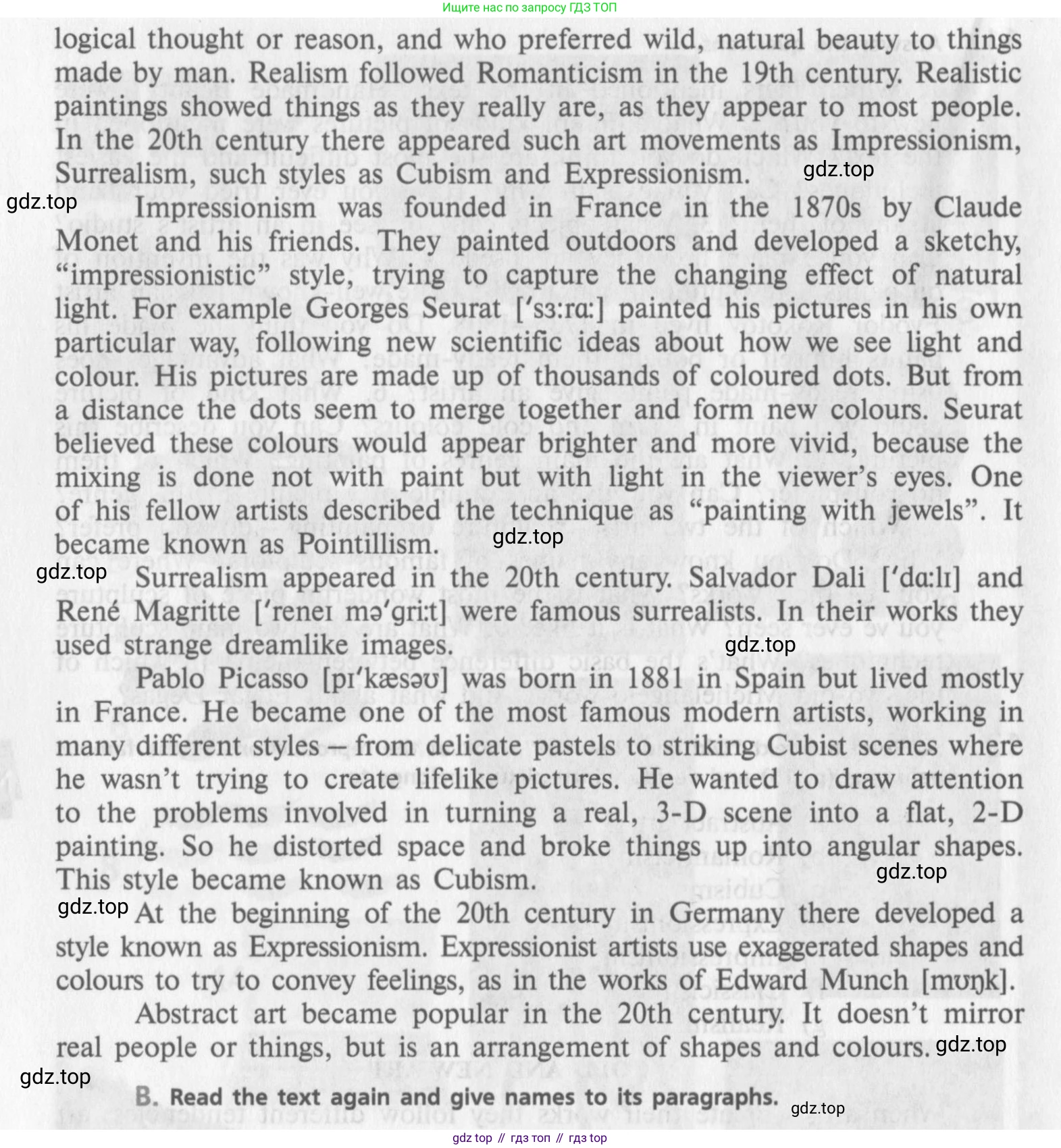Номер 12, страница 13 - гдз по английскому языку 10 класс учебник Афанасьева, Михеева

Авторы: Афанасьева О. В., Михеева И. В.
Тип: Student's book (Учебник)
Издательство: Просвещение
Год издания: 2014 - 2025
Уровень обучения: углублённый
Цвет обложки: белый, оранжевый с Биг Беном
ISBN: 978-5-09-027690-0
Популярные ГДЗ в 10 классе
Unit 1. Man the Creator. Reading - номер 12, страница 13.
№12 (с. 13)
Условие. №12 (с. 13)
скриншот условия


12. A. Read the text "Old and New Art", look at the reproductions of the famous paintings (p. 15) and decide which picture belongs to:
a) Abstract art
b) Romanticism
c) Cubism
d) Expressionism
e) Impressionism
f) Classicism
g) Realism
OLD AND NEW ART
When artists create their works they follow different tendencies, art movements and styles. When you examine paintings belonging to different periods you can see how ideas about art have changed over time. Classical works of art are connected with or influenced by the art of ancient Greece and Rome. They possess such qualities as balance, regularity and simpleness of form. In Europe in the 18th century Classicism was the quality of being simple, balanced and controlled, not giving way to feeling and following ancient models in contrast to Romanticism and Realism. In European art in the late 18th and early 19th centuries there appeared a group of artists who followed their feelings and emotions rather than
logical thought or reason, and who preferred wild, natural beauty to things made by man. Realism followed Romanticism in the 19th century. Realistic paintings showed things as they really are, as they appear to most people. In the 20th century there appeared such art movements as Impressionism, Surrealism, such styles as Cubism and Expressionism.
Impressionism was founded in France in the 1870s by Claude Monet and his friends. They painted outdoors and developed a sketchy, "impressionistic" style, trying to capture the changing effect of natural light. For example, Georges Seurat ['sɜːrɑː] painted his pictures in his own particular way, following new scientific ideas about how we see light and colour. His pictures are made up of thousands of coloured dots. But from a distance the dots seem to merge together and form new colours. Seurat believed these colours would appear brighter and more vivid, because the mixing is done not with paint but with light in the viewer's eyes. One of his fellow artists described the technique as "painting with jewels". It became known as Pointillism.
Surrealism appeared in the 20th century. Salvador Dali ['dɑːli] and René Magritte ['reneɪ mə'grɪt] were famous surrealists. In their works they used strange dreamlike images.
Pablo Picasso ['pɪ'kæsəʊ] was born in 1981 in Spain but lived mostly in France. He became one of the most famous modern artists, working in many different styles – from delicate pastels to striking Cubist scenes where he wasn't trying to create lifelike pictures. He wanted to draw attention to the problems involved in turning a real, 3-D scene into a flat, 2-D painting. So he distorted space and broke things up into angular shapes. This style became known as Cubism.
At the beginning of the 20th century in Germany there developed a style known as Expressionism. Expressionist artists use exaggerated shapes and colours to try to convey feelings, as in the works of Edward Munch ['mʊŋk].
Abstract art became popular in the 20th century. It doesn't mirror real people or things, but is an arrangement of shapes and colours.
B. Read the text again and give names to its paragraphs.
Решение. №12 (с. 13)


Решение 2. №12 (с. 13)
12. А. Прочитайте текст «Старое и новое искусство», посмотрите на репродукции известных картин (стр. 15) и решите, к какому стилю относится каждая картина: a) Абстракционизм, b) Романтизм, c) Кубизм, d) Экспрессионизм, e) Импрессионизм, f) Классицизм, g) Реализм.
12. Б. Прочитайте текст еще раз и дайте названия его абзацам.
Ответ:
A. Для ответа на вопрос недостаточно данных.
B.
Paragraph 1: Introduction to Art Movements / Параграф 1: Введение в художественные течения
Paragraph 2: Impressionism and Pointillism / Параграф 2: Импрессионизм и пуантилизм
Paragraph 3: Surrealism and Cubism / Параграф 3: Сюрреализм и кубизм
Paragraph 4: Expressionism and Abstract Art / Параграф 4: Экспрессионизм и абстракционизм
Другие задания:
Помогло решение? Оставьте отзыв в комментариях ниже.
Присоединяйтесь к Телеграм-группе @top_gdz
ПрисоединитьсяМы подготовили для вас ответ c подробным объяснением домашего задания по английскому языку за 10 класс, для упражнения номер 12 расположенного на странице 13 к Учебник (Student's book) 2014 года издания для учащихся школ и гимназий.
Теперь на нашем сайте ГДЗ.ТОП вы всегда легко и бесплатно найдёте условие с правильным ответом на вопрос «Как решить ДЗ» и «Как сделать» задание по английскому языку к упражнению №12 (с. 13), авторов: Афанасьева (Ольга Васильевна), Михеева (Ирина Владимировна), ФГОС (старый) углублённый уровень обучения учебного пособия издательства Просвещение.




















